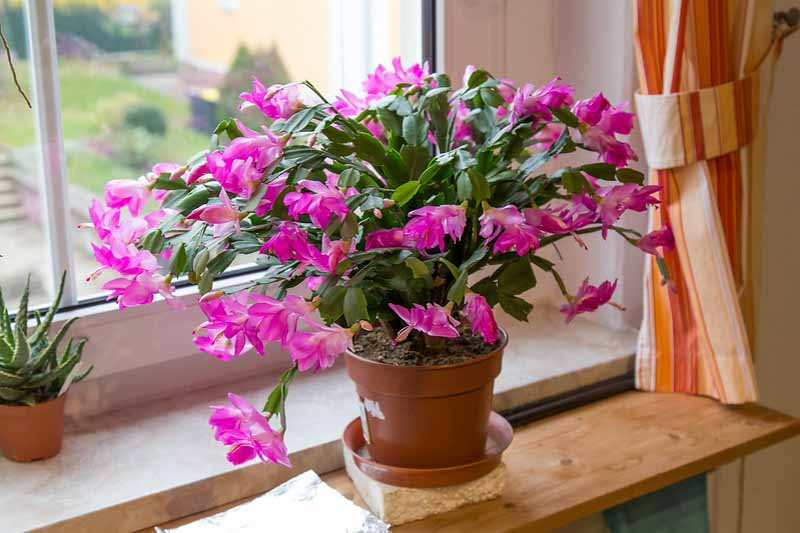Thanksgiving Cactus, Christmas Cactus, Crab Cactus, False Christmas Cactus, Zygocactus truncatus
Schlumbergera truncata, commonly known as the Thanksgiving Cactus, is a popular houseplant recognized for its segmented, flat, green stems and vibrant tubular flowers. The stem segments have pointed, claw-like projections on their edges, leading to its other common name, “Crab Claw Cactus.”
Native: This cactus is indigenous to the coastal mountains of southeast Brazil, specifically the cloud forests, where it grows as an epiphyte on trees or on rocky landscapes.
Plant Type and Habit: It’s an epiphytic cactus, meaning in the wild, it often grows on other plants. As a houseplant, it has a pendulous habit, with stems that cascade gracefully.
Size: The Thanksgiving Cactus usually reaches a height of about 12 inches (30 cm), with a spread of up to 24 inches (60 cm).
Flowers: It boasts tubular, asymmetrical flowers that can be pink, red, white, purple, or even yellow. The flowers have a unique, slightly curved shape.
Bloom Time: True to its name, the Thanksgiving Cactus typically blooms in late November, around the U.S. Thanksgiving holiday.
Foliage: Its distinctive green, flat stem segments (often mistaken for leaves) have pointed projections.
Hardiness: It is best suited for USDA zones 10-12. In colder regions, it’s grown as an indoor plant.
Uses: Primarily grown as an ornamental houseplant, its bright flowers and unique segmented stems make it a popular choice for adding a splash of color indoors.
Toxicity: Non-toxic to humans and pets, but ingestion may cause minor gastrointestinal upset.
Benefits:
Apart from its ornamental appeal, it’s an easy-to-care-for plant that can live for many years. Its ability to bloom during late fall adds color when many other plants are dormant.
Spectacular Blooms: The plant produces vibrant, tubular flowers that can brighten up any indoor space.
Easy Care: Adaptable to household conditions and requires minimal maintenance.
Long-Lived: With proper care, it can thrive for many years, becoming a cherished heirloom.
Air Purification: Like many houseplants, it can help improve indoor air quality.
Safe for Pets: Unlike many houseplants, the Thanksgiving Cactus is non-toxic to pets.
Seasonal Beauty: Blooms align with the holiday season, offering a natural decoration for festivities.
Compact Growth: Its size is suitable for apartments and smaller spaces.
Unique Appearance: The segmented stems and claw-like projections make it a conversation starter.
Emotional Well-being: The act of nurturing plants can offer therapeutic benefits and reduce stress.

Light: Provide bright, indirect light. Too much direct sunlight can scorch the leaves, while too little can prevent blooming.
Soil: Use a well-draining potting mix, ideally cactus or succulent mix.
Water: Allow the top inch of the soil to dry out between waterings. Reduce watering in the dormant winter period.
Fertilizer: Feed with a half-strength balanced liquid fertilizer every 2-3 weeks during the growing season (spring and summer).
Pruning: After blooming, you can prune the cactus to encourage bushier growth. This also provides cuttings for propagation.
Propagation: Take stem segments, let them dry for a day or two, and then plant them in moist potting soil.
Temperature: Keep in a room with temperatures between 65°F – 70°F (18°C – 21°C) during the day and cooler at night to encourage blooming.
Humidity: These cacti appreciate higher humidity, especially when buds are forming. If your home is dry, consider placing the pot on a tray with wet pebbles.
Bloom Encouragement: Starting in the fall, ensure the plant has extended periods of darkness (at least 12 hours) for about 6 weeks, along with cooler temperatures, to encourage bloom set.
Repotting: Repot every 2-3 years or when the plant outgrows its container. This provides fresh soil and space for growth.
Remember, Thanksgiving Cactus is an epiphyte in the wild, growing in tree branches, so it prefers conditions different from desert cacti. Adjust your care routine accordingly.
Getting your Thanksgiving Cactus to bloom requires mimicking its natural habitat conditions to induce the flowering process. Here’s a step-by-step guide:
Light Exposure: These cacti need long nights to set buds. Starting in the fall, ensure your plant has around 12-14 hours of darkness each night for at least six weeks. You can either move it to a dark room or cover it with a cloth or box. Ensure it gets bright, indirect light during the day.
Temperature: Cooler temperatures can encourage blooming. Maintain nighttime temperatures between 55°F-60°F (13°C-15°C) and daytime temperatures between 65°F-70°F (18°C-21°C). A slight drop in temperature can signal the plant to begin the blooming process.
Limit Watering: Starting in the fall, reduce watering slightly. Let the top layer of soil dry out before watering again. This mimics the natural dry period they experience in their native habitat.
Fertilize: During the growing season (spring to early autumn), feed the cactus with a balanced, water-soluble fertilizer every 2-3 weeks. Stop fertilizing as you approach the blooming period.
Humidity: Schlumbergera species appreciate humidity, especially when they are setting buds. If your home’s air is dry, consider placing the pot on a tray filled with water and pebbles, ensuring the pot’s base isn’t submerged. The evaporating water will increase humidity around the plant.
Avoid Moving: Once buds have formed, try not to move the cactus. A sudden change in its environment can cause the buds to drop.
Avoid Stress: Keep the cactus away from drafty windows, doors, or heating vents. Rapid temperature fluctuations or drafts can stress the plant and inhibit blooming.
After the blooming period, revert to the regular care routine, ensuring it gets proper rest and rejuvenation for the next blooming cycle. Remember, consistency is key. If the Thanksgiving Cactus doesn’t bloom one year, make adjustments and try again the next year. Sometimes it takes a bit of tweaking to get the conditions just right.

Thanksgiving Cactus is generally an easy-to-care-for plant, but like all plants, it can experience certain issues. Here are common problems you might encounter and their causes:
Bud Drop: One of the most disheartening issues is when a Thanksgiving Cactus develops buds, only to drop them before they open. Causes: Changes in temperature, light, or humidity; over-watering; or drafts.
Leaf Drop: It’s normal for the cactus to drop an occasional leaf, but if it’s excessive, there’s a problem. Causes: Over-watering, under-watering, or sudden changes in temperature or light conditions.
Limp or Wrinkled Segments: Causes: Typically due to under-watering or root rot from prolonged wet conditions.
Discolored or Soft Segments: Causes: This can be a sign of root rot, usually due to over-watering or poor drainage.
Failure to Bloom: Inadequate dark period, temperatures too high or too low, or not enough difference between day and night temperatures.
Edema: Raised, scab-like areas on the undersides of the leaf segments. Often due to inconsistent watering. It happens when the plant takes up water faster than it can use it, causing cells to burst.
Leaf Tip Browning: Causes: Low humidity, high salts in the water, or over-fertilization.
Reddish-Purple Leaf Coloration: Exposure to excessive sunlight. Thanksgiving Cactus prefers indirect light.
Mold or Mildew: White, powdery substances on the surface of the plant. Causes: Poor air circulation and high humidity.
Pests and diseases:
To address these issues, it’s essential to provide consistent care, monitor watering practices, ensure the plant is in the right location regarding light and temperature, and check regularly for pests. Adjusting care routines can often alleviate and prevent these common problems.
|
|
|
Propagating a Thanksgiving Cactus (Schlumbergera truncata) is relatively easy. Here’s a step-by-step guide to propagate them using stem cuttings:
Prepare Materials:
Select a Healthy Segment:
Take the Cutting:
Let it Callus:
Plant the Cutting:
Water Sparingly:
Provide Ideal Conditions:
Wait for Roots:
Transplant If Necessary:
Care for the New Plant:
Remember, the best time to take cuttings for propagation is in the spring or early summer, after the cactus has finished blooming. This gives the new plant ample time to grow and establish itself before the next blooming season.
Both the Thanksgiving cactus (Schlumbergera truncata) and Christmas cactus (Schlumbergera bridgesii) are holiday cacti, but they have distinct characteristics:
A Thanksgiving cactus prefers bright but indirect light. An east-facing window is ideal, but a shaded southern or western window works as well. Direct sunlight, especially during the intense afternoon hours, can scorch the plant.
Several factors induce blooming in a Thanksgiving cactus:
No, the Thanksgiving cactus prefers bright but indirect sunlight. While they can tolerate some direct morning sunlight, they should be shielded from the intense afternoon sun. Prolonged exposure to direct sunlight can cause their leaves to become discolored or scorched. If the plant is exposed to direct light, it’s best to provide some shade or move it to a location where the light is diffused.
| Hardiness |
10 - 12 |
|---|---|
| Heat Zones |
1 - 12 |
| Climate Zones | 16, 17, 21, 22, 23, 24, H1, H2 |
| Plant Type | Houseplants, Cactus & Succulents |
| Plant Family | Cactaceae |
| Common names | Christmas Cactus, Thanksgiving Cactus |
| Exposure | Partial Sun |
| Season of Interest |
Spring (Early, Mid, Late) Summer (Early, Mid, Late) Fall Winter |
| Height |
6" - 1' (15cm - 30cm) |
| Spread |
1' - 2' (30cm - 60cm) |
| Maintenance | Low |
| Water Needs | Low |
| Soil Type | Loam, Sand |
| Soil pH | Acid, Neutral |
| Soil Drainage | Moist but Well-Drained, Well-Drained |
| Characteristics | Showy, Evergreen |
| Garden Uses | Patio And Containers |
| Hardiness |
10 - 12 |
|---|---|
| Heat Zones |
1 - 12 |
| Climate Zones | 16, 17, 21, 22, 23, 24, H1, H2 |
| Plant Type | Houseplants, Cactus & Succulents |
| Plant Family | Cactaceae |
| Common names | Christmas Cactus, Thanksgiving Cactus |
| Exposure | Partial Sun |
| Season of Interest |
Spring (Early, Mid, Late) Summer (Early, Mid, Late) Fall Winter |
| Height |
6" - 1' (15cm - 30cm) |
| Spread |
1' - 2' (30cm - 60cm) |
| Maintenance | Low |
| Water Needs | Low |
| Soil Type | Loam, Sand |
| Soil pH | Acid, Neutral |
| Soil Drainage | Moist but Well-Drained, Well-Drained |
| Characteristics | Showy, Evergreen |
| Garden Uses | Patio And Containers |
How many Schlumbergera truncata (Thanksgiving Cactus) do I need for my garden?
| Plant | Quantity | |
|---|---|---|
| Schlumbergera truncata (Thanksgiving Cactus) | N/A | Buy Plants |
Create a membership account to save your garden designs and to view them on any device.
Becoming a contributing member of Gardenia is easy and can be done in just a few minutes. If you provide us with your name, email address and the payment of a modest $25 annual membership fee, you will become a full member, enabling you to design and save up to 25 of your garden design ideas.
Join now and start creating your dream garden!
Create a membership account to save your garden designs and to view them on any device.
Becoming a contributing member of Gardenia is easy and can be done in just a few minutes. If you provide us with your name, email address and the payment of a modest $25 annual membership fee, you will become a full member, enabling you to design and save up to 25 of your garden design ideas.
Join now and start creating your dream garden!